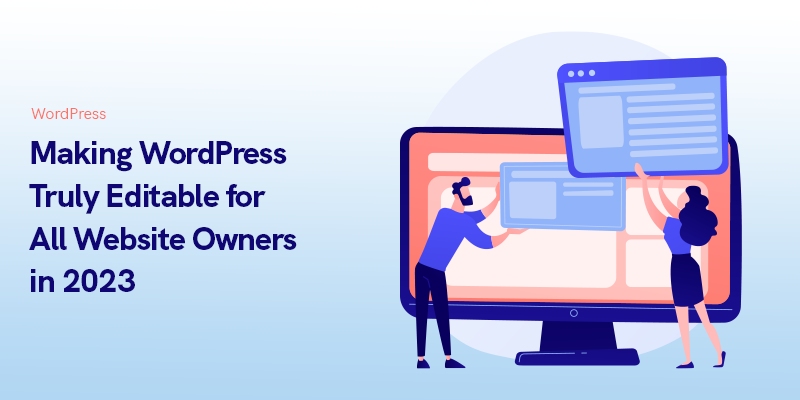As an experienced WordPress user, the chances are that you’re already quite capable of building a WordPress website and editing it at will. But how many end users and owners of websites complain to WordPress developers that they don’t understand how to even update text on a page, let alone update images or change a logo?
The Role of a Digital Adoption Platform (DAP)
But all that could change with the advent of a Digital Adoption Strategy by using a Digital Adoption Platform (DAP). A DAP is a teaching layer of software that runs alongside its primary platform, and its function is to offer help to software users as and when they need it. The beauty of a DAP is that it harnesses artificial intelligence (AI) to hyper-personalize the teaching experience. It does this by ‘learning’ the workflow style and habits of the software user. This means that as soon as the operator tries to do something that will either not work or turn out to be redundant effort, the DAP will offer a ‘tooltip’ or even an audio message if required, advising the person that their actions are erroneous.
Of course, there’s a risk of these ‘advisory messages’ becoming extremely irritating very quickly, which is why the AI learns to stop offering that particular assistance as soon as the software user appears to have mastered the process in question. It achieves this on a one-to-one individualized basis by working with the user’s logged in account, not simply regarding every logged-on user as generic. In short, some people need lots of help from a DAP, some none at all. The DAP learns who these individuals are and acts accordingly.
Take a fictitious but all too real example of a website built in WordPress for a small business that manufactures doors and windows of hardwood. The chances are that the managers of the business are going to be better carpenters than website editors and might easily struggle when it comes to logging into the back end of their WordPress site to add special offers or change images of their latest new products.
Benefits of a DAP for WordPress Users
If A DAP was running alongside the WordPress instance, the interaction between user and computer screen might go something like this:
User goes to log on to the WordPress site via www.anyjoiner.com/wp-login.php and the first thing they encounter is a message saying that WordPress needs to be updated but their version of PHP won’t support the suggested update. At this point, many WordPress novices would stop what they were doing and immediately call their WordPress developer or their web hosting company to find out how to solve the problem. However, a DAP might immediately offer up a message next to the standard WordPress dialogue stating something like:
“PHP upgrades aren’t always necessary, and this is something normally controlled by your web hosting company. Just screenshot the WordPress message and send it to your host if you are concerned…”
The same goes for when people try to upload image files of the wrong format, add plugins that may not be compatible with their version of WordPress or do something more complex like add a calendar or social media widget in a sidebar. While WordPress itself assumes a certain level of operator knowledge and competence, a DAP can walk the user through even the most basic of operations. In fact, many WordPress novices are concerned that they’ll break something, fall foul of privacy legislation or even bring their own website down, rather than just make a simple spelling mistake. A DAP could reassure a novice operator by adding tooltips such as:
“Changing this menu configuration will alter the appearance of the footer menu, but not the links menu at the top of your home page. Are you sure you want to do this?” – but after the user has altered menus more than a couple of times, the DAP will learn that the operator has become confident with that particular process and not pester them again.
Extending DAP's Impact Beyond WordPress
But of course, it’s not only WordPress that can benefit from the addition of a DAP. Everyone from designers of driverless cars to a home user setting up a Smart TV or employees in corporate offices can benefit from this tech; along with the manufacturers of consumer electronics and software designers. This is because another significant advantage of a DAP is found in its reporting capabilities.
If a Smart TV setup wizard was equipped with a DAP running alongside it, not only does the end-user benefit, but crucial feedback can be received by the designer of the TV wizard. The DAP will report back with common mistakes made by end users, and if it becomes evident that a significant proportion of consumers are all pressing the wrong buttons on their remote controls at a given point in the set-up procedure, there’s something wrong with the way the wizard is constructed, rather than the inabilities of operators.
Likewise, if an office full of corporate employees are all making the same mistake at the same fields when trying to input data, it’s likely to be the fault of the user experience design (UX) and user interface (UI) that is causing the problem, as opposed to mass human incompetence. Crucial feedback gleaned from this data can be sent to software designers in order to alter workflow processes as a result.
Conclusion
In summary, whether you’re asking a carpenter to update a WordPress website or helping a grandmother to watch her favorite films on Netflix, a DAP has to be a smart move for any technology in the home or office.

